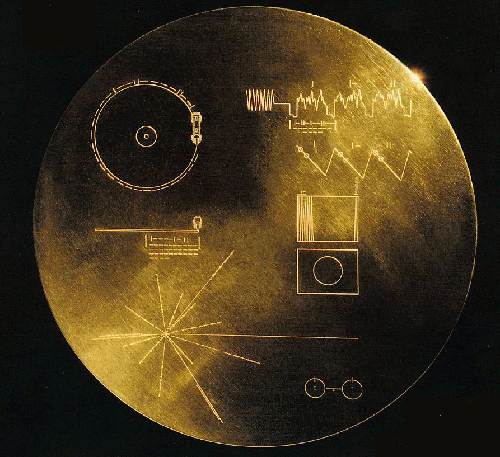
(The Pioneer Plaque, courtesy of enterprisemission.com)
Voyagers' Golden Records
Along with Pioneer 10 and Pioneer 11, the two Voyager Space Probes are rapidly leaving the Solar System and heading out to interstellar space. With these four spacecraft, mankind has finally thrown something up that will never come down.
Being humanity's first physical emissaries to the stars, NASA saw fit provide these four probes with messages from humanity to whomever or whatever may find these artifacts among the stars. If, millions of years from now, some alien civilization discovers one of our probes, the basic identity and location the machine's creators should be deducible.
The Pioneer spacecraft were equipped with gold-anodized, aluminum plaques. The plaques were designed by Dr. Carl Sagan and Dr. Frank Drake and drawn by Dr. Sagan's wife Linda Sagan. The Pioneer plaques used the hydrogen atom as a basis for describing the location of our solar system in the Milky Way and the relative locations of the planets in our solar system. Additionally, the plaques contained a picture of a man and a woman, and indicated the location of their home, Earth, in our solar system (from “A Message from Earth” by Carl Sagan, Linda Salzman Sagan, and Frank Drake, available at http://www.enterprisemission.com/pioneer.html).

(The
Pioneer Plaque, courtesy of enterprisemission.com)
Not content to rest on their previous accomplishment, Carl Sagan and his associates were also responsible for the design and content of the next “message from earth” attached the Voyager space probes. Unlike the simple plaques of the Pioneer craft, the Voyager probes were equipped with 12-inch gold-plated copper records. In addition to the hydrogen atom mathematical key, etched onto the surface of each plaque were directions on how to play the record using an enclosed needle and cartridge. The record's surface was coated with pure Uranium-238 to indicate the launch era of the probe. Also, the record's surface contained the same pulsar charter used on the Pioneer plaques to pinpoint the location of our solar solar system in the galaxy (see http://voyager.jpl.nasa.gov/spacecraft/goldenrec1.html).

(The
Golden Record, courtesy of nasa.gov)
Contained in these golden records are sounds, music, and images that Dr. Sagan and his associates felt represented the variety life and culture of Earth. Included were 115 pictures, 55 spoken greetings in as many language, a selection of natural and man-made sounds, and a 90 minute collection of music from around the world. The diversity of the data contained on the golden record is astounding. The record holds greetings in most of the major languages spoken today, as well as many ancient one, such as Sumerian and Akkadian. In a similar vein, the music collection contains tracks ranging from Beethoven to Chuck Berry to traditional music from locales such as Java and Senegal. The images included in the golden record are used to illustrate scientific concepts, showcase the natural and man-made worlds of Earth, and characterize the behavior of humanity (from http://re-lab.net/welcome). See http://re-lab.net/welcome/ for a complete listing of the sounds and images on the golden records.
The Golden Records stand as a testament to the diversity of humanity and the planet Earth. Dr. Carl Sagan and his associates were faced with the herculean task of describing mankind and our planet to beings without even basic ideas about us. Their solution was quite ingenious, and hopefully, will pay off one day.
[Home]
[Voyager Program History] [Voyager Probe Technology] [Voyager Images] [The Golden Record] [Where Are They Now?] [Bibliography/Links]